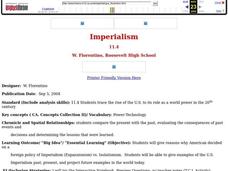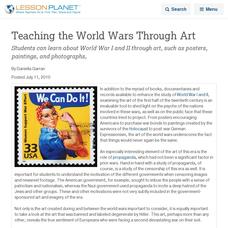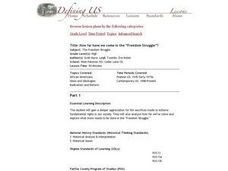Curated OER
Major Events Leading to the American Revolution
Students explore the causes of the American Revolution. In this taxation without representation lesson plan, students analyze political cartoons in order to gain an understanding of the efforts of the colonists to resolve conflict with...
Curated OER
Imperialism
Students explore the concept of Imperialism. In this foreign policy lesson, students examine the policies of the US and other countries through time. Students then create a political cartoon of their own and create a timeline that...
Curated OER
The Great Depression
Seventh graders investigate the implications of economic fallout. In this Great Depression lesson, 7th graders analyze political cartoons and documents about the era. Students then conduct further primary source research about the toll...
Curated OER
Canada's Press: Making a Historical Newspaper
Young scholars examine several colonial-era editorial cartoons. They evaluate the effectiveness of the techniques the cartoonists used to display their messages and share one editorial cartoon with the class emphasising what message has...
Alabama Department of Archives and History
Alabama and the Treaty of Versailles
As part of a study of the treaty that ended World War I and the seeds of resentment it planted, class groups compare President Wilson's Fourteen Points and the articles of the Treaty of Versailles.
DocsTeach
Prohibition and Its Consequences
Organized crime and speakeasies ... just another day during Prohibition. An intriguing activity explores the world of Prohibition and its consequences on life in the United States. Scholars analyze primary sources and place them on a...
Tennessee State Museum
Understanding Women’s Suffrage: Tennessee’s Perfect 36
Tennessee was the pivotal state in ratifying women's suffrage in 1920, with its vote coming down to one man: Harry Burn, a 24-year old state representative who changed his nay to an aye on the advice of his mother. Learn more about...
Digital Public Library of America
The Underground Railroad and the Fugitive Slave Act of 1850
Escaping Enslaved people attempting to escape didn't need a ticket to ride on the Underground Railroad. Here is a packet of primary sources that reveal the kind of courage and determination they did need to face the challenges to gain...
Curated OER
Wilson and American Entry into World War I
Students explore the events that led to American entry into World War I. In this American history lesson plan, students examine the policies of Woodrow Wilson at the dawn of the war, analyze challenges to the neutrality policy of the...
Curated OER
Teaching the World Wars Through Art
Students can learn about World War I and II through art, such as posters, paintings, and photographs,
Curated OER
Using Primary Sources to Discover Reconstruction
Fifth graders discover how reconstruction had an impact on racial issues in the United States. In this Reconstruction lesson, 5th graders are introduced to primary vs. secondary resources and then rotate through stations to view...
Curated OER
The Election of 1896 - Gold or Silver?
Students analyze the issues behind the Election of 1896 and describe the positions of William McKinley and William Jennings Bryan. They evaluate editorial cartoons supporting McKinley's candidacy via editorial cartoons. Each student...
Curated OER
The Red Scare
Students identify and interpret issues of Nativism and Protectionism in early 20th Century America. They analyze the roots of anti-immigrant movements in the Post-World War One United States. Finally, students identify and explore the...
Curated OER
National Debate Over Treaty Ratification
Students review the main points of the Versailles Treaty. In groups, they analyze a variety of political cartoons about Wilson and the treaty itself and share their findings with the class after completing a worksheet. To end the...
Curated OER
Historical Lessons on Wartime and Race Relations
Students identify perceptions towards Asians widely held by the American public through the analysis of political cartoons from the 1940's. They recognize the ramifications of such perceptions on Asian American and Arab American.
Curated OER
The 1860 Election in Pennsylvania
Young scholars examine the political parties of the 1860 election and compare their platforms. In this election lesson young scholars determine the meaning of a political cartoon and predict the outcome of the 1860 election.
Curated OER
Chinese Immigration 1860s-1880s
Eighth graders consider the plight of Chinese immigrants to America. For this immigration lesson, 8th graders analyze political cartoons from the late 1800's that exemplify American public opinion regarding Chinese immigrants. The...
Curated OER
Spanish-American War
Middle schoolers view a video called Battling Beyond the Borders about the Spanish-American War. They discuss the role of newspapers in the war and then analyze political cartoons of the time, writing explanatory sentences about them.
Curated OER
Jeffersonianism at the Bar
Eleventh graders participate in a political roundtable discussion. In this Jeffersonianism lesson, 11th graders role play individuals from the 19th century and discuss issues of the Federalist period.
Curated OER
Day you were born newspaper
Pupils construct a newspaper about historical events that happened on the day they were born. In this newspaper lesson plan, students write an editorial, create a visual, find a political cartoon, and insert an interview.
Curated OER
How far have we come in the "Freedom Struggle"?
Eleventh graders assess an appreciation for the sacrifices made to achieve fundamental rights in our society. They analyze how far we've come to explore what more needs to be done in the "Freedom Struggle." Each student completes a...
Curated OER
United States-Japanese Relations in Post World War II Era
Ninth graders analyze political cartoons and posters relating to the United States and Japan in the period following World War II. They discuss the positive and negative consequences of the United States occupation of Japan.
Curated OER
The Imperialist Vision
Students explore imperialism and why the United States became an imperial power. After reading from their textbook and answering questions, students compare and contrast two political cartoons. They create a bubble map of events...
GCSE Modern World History
Mao's China
Here is a great textbook chapter on China's establishment as a communist state in 1949 and the effects of World War II on the nation. The first page prompts learners to complete a timeline activity as they read the material, which...

























